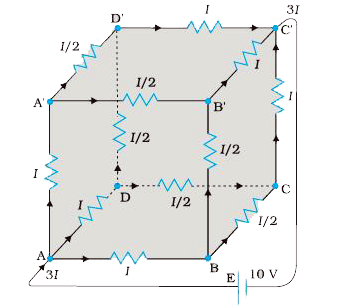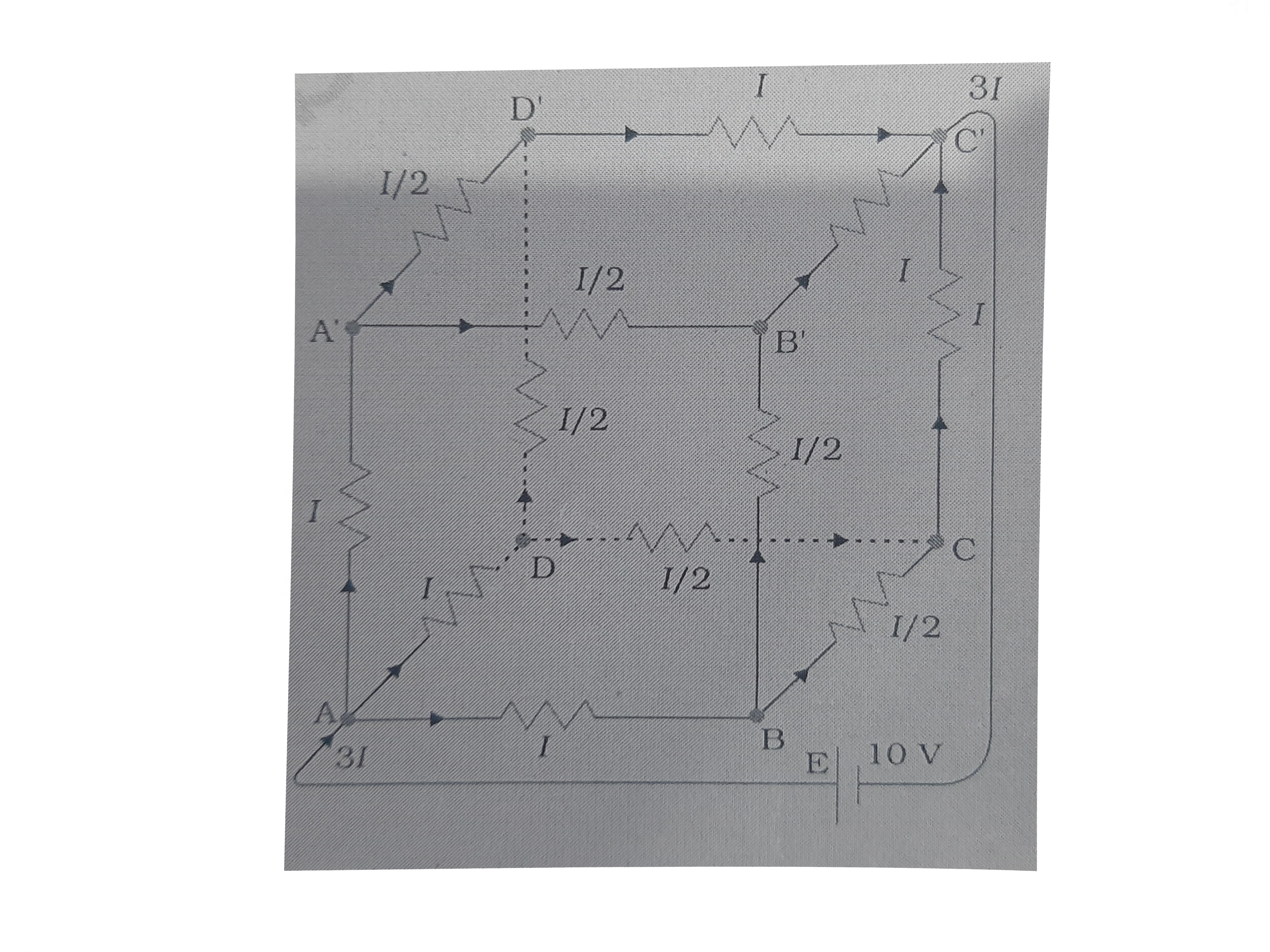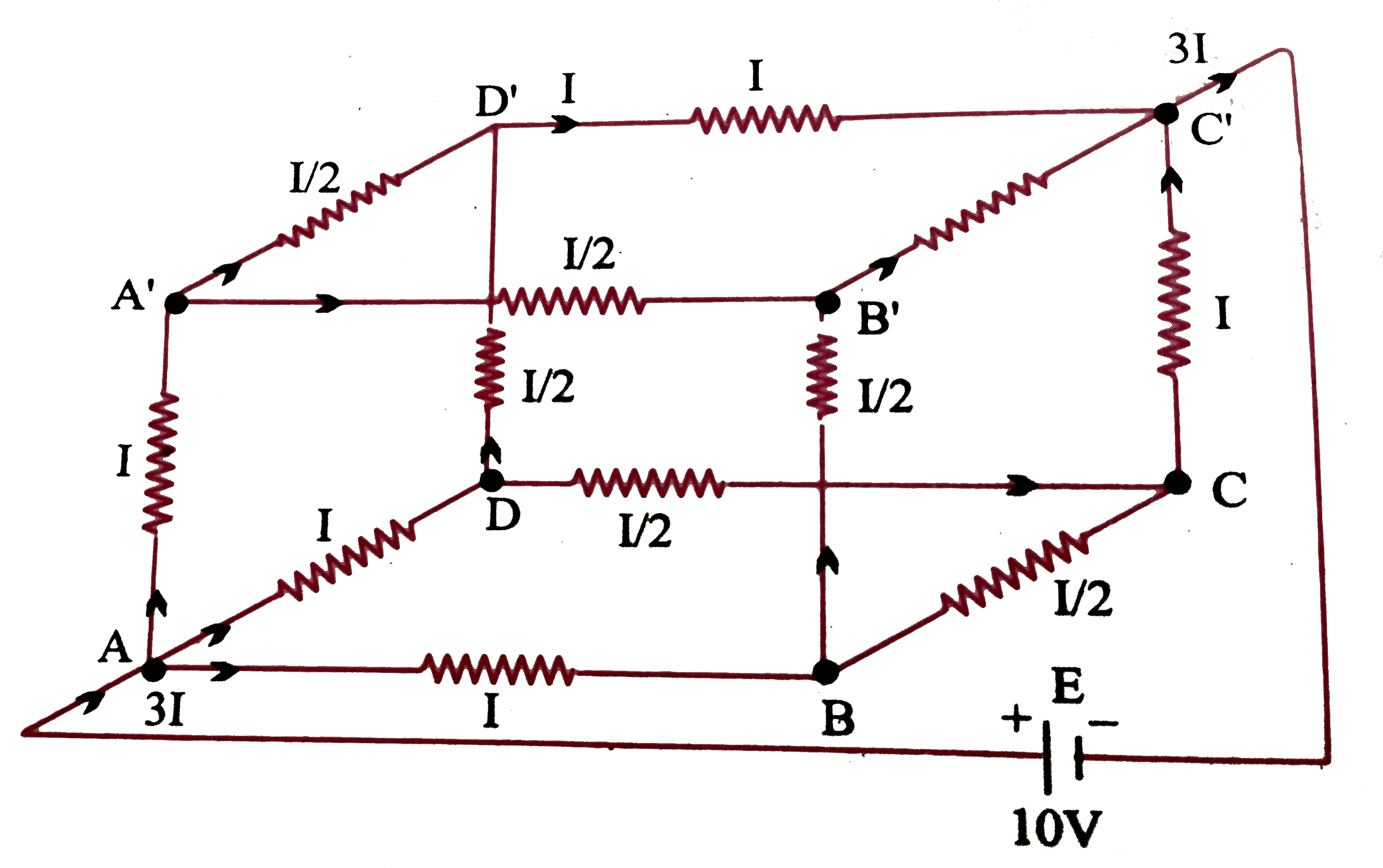A bettery of 10 V and negligible internal resistance is connected across the diagonally opposite corners of a cubical network consisting of 12 resistors each of resistance 1Ω Determine the equivalent resistance of the network and the current along each edge of the cube.
 Solution in Gujrati
Solution in Gujrati
The network is not reducible to a simple series and parallel combinations of resistors. There is, however, a clear symmetry in the problem which we can exploit to obtain the equivalent resistance of the network.
The paths AA..AD and AB are obviously symmetrically placed in the network. Thus, the current in each must be the same, say, I. Further, at the corners A.,B and D, the incming current I must split equially into the two outgoing branches. In this manner, the current in all the 12 deges of the cube are esaily written down in terms of I, using kirchhoffs first rule and the symmetry in the problem.
Next take a closed loop, say. ABCCEA, and apply kirchhoffs second rule:
ε=52IR
The equivalent rsistance Req of the network is
Req=ε3I=56R
For R=1Ω,Req(5/6)Ωand for ∈=10V, the total current (=3I) in the network is
3I=10V(5/6)Ω=12A,i.e.,I=4A
The current following in each edge can now be read off from the
Topper's Solved these Questions
- CURRENT ELECTRICITY BOOK - NCERT GUJARATICHAPTER - CURRENT ELECTRICITY EXERCISE - EXERCISES
12 Videos
- CURRENT ELECTRICITY BOOK - NCERT GUJARATICHAPTER - CURRENT ELECTRICITY EXERCISE - ADDITIONAL EXERCISES
9 Videos
- ATOMSBOOK - NCERT GUJARATICHAPTER - ATOMSEXERCISE - ADDITIONAL EXERCISE
10 Videos
- DUAL NATURE OF RADIATION AND MATTERBOOK - NCERT GUJARATICHAPTER - DUAL NATURE OF RADIATION AND MATTEREXERCISE - EXERCISES
41 Videos
Similar Questions
The storage battery of a car has an emf of 12 V. If the internal resistance of the battery is 0.4Ω what is the maximum current that can be drawn from the battery ?
View SolutionThe earth's surface has a negative surface charge density of 10−9Cm−2. The potential difference of 400 kV between the top of the atmosphere and the surface results (due to the low conductivity of the lower atmosphere) in a current of only 1800 A over the entire globe. If there were no mechanism of sustaining atmospheric electric field, how much time (roughly) would be required to neutralise the earth's surface? (This never happens in practice because there is a mechanism to replenish electric charges. namely tghe coontainual thunderstorms and lighting in different parts of the globe). (Radius of earth =6.37×106m.)
View SolutionAnswer the following questions, which help you understand the difference between Thomson’s model and Rutherford’s model better.
(a) Is the average angle of deflection of a-particles by a thin gold foil predicted by Thomson’s model much less, about the same, or much greater than that predicted by Rutherford’s model?
View SolutionFind the
(a) maximum frequency, and
(b) minimum wavelength of X-rays produced by 30 kv electrons.
View SolutionA battery of 15 V and negligible internal resistance is connected across the diagonally opposite corners of a cubical network consisting of 12 resistors each of resistance 5Ω 22. Determine the equivalent resistance of the network and the current along each edge of the cube.

View SolutionBattery of 10 V and negligible internal resistance is connected across the diagonally opposite corners of a cubical network consisting of 12 resistors each of resistance 1 Omega (Fig. 3.23). Determine the equivalent resistance of the network and the current along each edge of the cube.
View Solution10 V तथा नगण्य आंतरिक प्रतिरोध की बैटरी एक घनीय परिपथ जाल ( नेटवर्क ) के "विकदत" सम्मुख कोनो से जुडी है परिपथ जाल में 1PΩ प्रतिरोध के 12 प्रतिरोधक है ( चित्र 3 .23 ) l परिपथ जाल का समतुल्य प्रतिरोध तथा धन के प्रत्येक के अनुदिश विधुत धारा ज्ञात कीजिए l

View SolutionA network of resistor is connected to a 16 V battery with internal resistance of 1 Omega , a shown in fig. (a) complete the equivalent resistance of the network.
View Solution10 V तथा नगण्य आंतरिक प्रतिरोध कि बैटरी एक घनीय परिपथ जाल ( नेटवर्क ) के विकर्णताः सम्मुख कोनो से जुडी है । निम्न परिपथ जाल में 1Ω प्रतिरोध के 12 प्रतिरोधक है । परिपथ जाल का समतुल्य प्रतिरोध तथा घन के प्रत्येक किनारे के अनुदिश विद्युत धारा ज्ञात कीजिए ।

View SolutionTwelve wires, each of resistance 1Ω are connected to form a skeleton cube. Battery of 10V and neglibible internal resistance is connected across diagonally opposite corners of the cube. Determine the equivalent resistance of the network and current supplied by the battery.
View SolutionA network of resistors is connected to a 5 V battery with internal resistance of 1Omega as shown in Fig. (a) Compute the equivalent resistance of the network. (6) Obtain the current in each resistor. (c) Obtain the voltage drops V_(BC) and V_(CD)
View SolutionA battery of 15 V and negligible internal resistance is connected across the diagonally opposite corners of a cubical network consisting of 12 resistors each of resistance 5Omega 22. Determine the equivalent resistance of the network and the current along each edge of the cube.
View SolutionA bettery of 10 V and negligible internal resistance is connected across the diagonally opposite corners of a cubical network consisting of 12 resistors each of resistance 1Ω Determine the equivalent resistance of the network and the current along each edge of the cube.

View SolutionA bettery of 10 V and negligible internal resistance is connected across the diagonally opposite corners of a cubical network consisting of 12 resistors each of resistance 1Ω Determine the equivalent resistance of the network and the current along each edge of the cube.

View SolutionBattery of 10 V and negligible internal resistance is connected across the diagonally opposite corners of a cubical network consisting of 12 resistors each of resistance 1 Omega (Fig. 3.23). Determine the equivalent resistance of the network and the current along each edge of the cube.
View Solution
